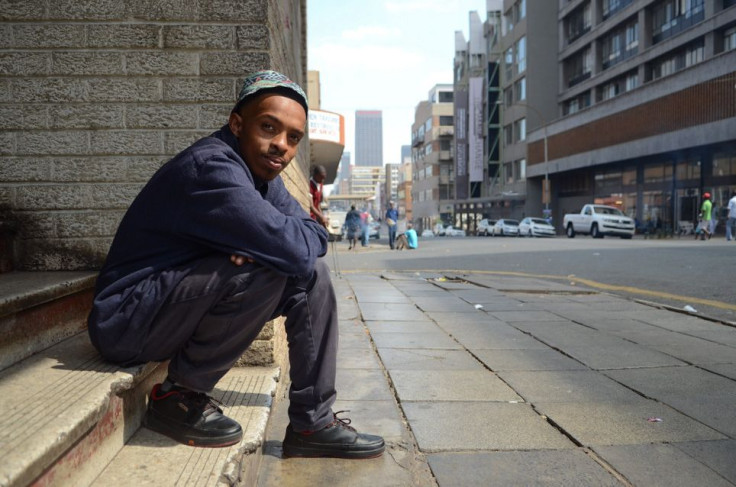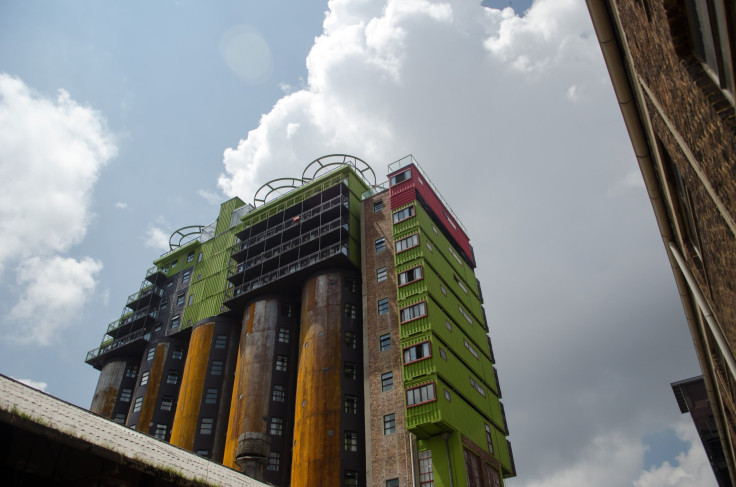In Johannesburg, Once Known For Apartheid, Gentrification Means Displacement For The Poor

JOHANNESBURG – Jabu Khwela was rehearsing a monologue for his theater class one morning when he heard the sirens and then the shouting of a private security team outside his home.
Minutes later, the 20-year-old student and his family were forced onto the street with all their belongings. Along with 50 other low-income residents, they were being evicted from living spaces they had informally rented -- without a lease -- in an industrial building in this city’s Jeppestown neighborhood.
Khwela’s family and their neighbors were displaced to make way for the redevelopment of the gritty industrial area into Maboneng, an arts mecca with pricey loft apartments, chic cafes and independent movies theaters. They are just some of the Johannesburgers whose lives are being upended by the city’s gentrification efforts, including several massive projects that include tony new arts districts where galleries and overpriced lattes are the norm. It’s a process that mirrors other transformations in neighborhoods around the world, from Brooklyn’s Williamsburg to Berlin’s Prenzlauer Berg.
Once a symbol of racial apartheid and economic disparity, this city of 3.5 million is positioning itself as a model for sustainable redevelopment against a backdrop of growing African economies and increasingly urban populations. In the unabashedly promotional terms of its executive mayor, Mpho Parks Tau, Johannesburg is “a city at work to remake itself,” though that process can have unforeseen consequences.
Beyond the upscale developments, the familiar downside of gentrification -- the displacement of poorer residents -- is equally pronounced in the South African city, leading some to worry that rejuvenation will simply result in a new version of an old problem, summed up by the local saying that “money talks and the poor walk.”
For poor residents such as Khwela, the push to gentrify large swaths of run-down neighborhoods is a new chapter in the same kind of displacement that took place in apartheid-era Johannesburg when wealthy people set their sights on coveted real estate.
For Propertuity, the redevelopment of Khwela’s old neighborhood represents an opportunity. The company has invested almost R1 billion ($100 million USD) to buy and redevelop 40 properties on the city's eastern edge, most of them abandoned office buildings and light industrial spaces.
The project began with the refurbishing of an old construction office and warehouse as artists’ studios, galleries and work spaces. That first building, now called Arts on Main, is the epicenter of 13 renovated properties that have attracted 1,500 residents and more than 50 new businesses.
The neighborhood has become a hotbed for arts and fashion, with studio spaces, loft-style apartments and chic cafes. Craft beer and artisan pizza are sold next to the independent movie theater, and a gourmet coffee at a local shop can cost upwards of R20. The appeal to an up-market clientele often attracts comparisons to the gentrification of New York City and Seattle, though Jonathan Liebmann, CEO of Propertuity, sees it differently. Displacement, he said, is less an issue in Johannesburg because ample affordable housing is available to those who are displaced.
The Johannesburg municipality's urban rejuvenation plan, which began in 2005 when government-funded redevelopment in the inner city sparked the interest of commercial developers, is, in fact, remaking the city. The municipality spends roughly R10 billion ($1 billion USD) per year on infrastructure development. While the city spent only R450 million ($45 million USD) on developing new precincts, private investors say they are easily spending 10 times that each year.
Johannesburg is being remade as “a global African city” (a popular branding phrase) to rival booming metropolises like Lagos and Nairobi. The question that remains is whether it will be a model for other African cities and countries, or if its redevelopment will compound the inequalities that originally drove Johannesburg into disrepair.
“In Johannesburg, people are willing to forego a lot of these questions because it offers them a sort of bourgeois security,” says Mpho Matsipa, head of the newly opened Studio-X Johannesburg, which is located in Maboneng. The urban think tank, affiliated with Columbia University's Graduate School of Architecture, Planning and Preservation, is reimagining the potential for inclusive development in Johannesburg and around the world. Matsipa said that even as the effects of gentrification are debated in neighborhoods like Maboneng, other areas are being left out of the discussion altogether and are overlooked in the city’s redevelopment plans. “If you have these well-governed spaces that function well because they've been privatized, what does that mean for the people that are on the outside of that?” he asked. “Where do they get to have their utopia?”
Affordable housing is a part of the mix. Development projects to date fall into two categories: single buildings that provide affordable accommodation, but not much else, and affluent new “lifestyle” neighborhoods where residential and commercial development occurs side by side.
“People like a city lifestyle,” said Paul Lapham, CEO of Citiq, a property investment and management company. “They like being able to walk around on weekends and go to the local cafe, and not necessarily get in their car and go to a shopping center.”
Since being founded in 2008, Citiq has developed 29 properties around Gauteng province, many of which became affordable housing units for people in the city. Most recently the company repurposed an unused grain silo in Johannesburg's Newtown precinct to create an affordable student housing building. Located a short shuttle ride from several universities, the property provides accommodation for 370 students starting at R2625 ($262 USD) per month. Lapham is now focusing more efforts on the city center, with plans to develop a lifestyle neighborhood in Newtown.

“I personally love Newtown as a redevelopment option,” Lapham told International Business Times. “Newtown has easy access to the highway, there's a brand-new, big shopping center going up there. That's what all these areas have actually been missing.” The shopping center, the R1.3 billion ($130 million USD) Newtown Junction project, designed by Atterbury Property Holdings, has been a major part of the draw. Attempts by the municipality to rejuvenate Newtown five years ago, including redevelopment of public spaces including Mary Fitzgerald Square and Turbine Hall, failed to gather additional momentum from private investors. “One of the reasons for it stalling was that they had now signed this deal with Atterbury to design the shopping center,” Lapham said. City officials had surmised that doing so would attract more private commercial investment. But then bureaucratic holdups caused a massive delay in breaking ground on the project. “The problem is that it's taken five years from when they signed the deal to actually begin construction,” he said.
Lapham is unequivocal about the value of the Maboneng project, which he says has benefited the city by redeveloping residential, business and commercial properties simultaneously, ensuring a multifaceted “city lifestyle.” Lapham must rely upon existing commercial projects to ensure that amenities like shops and restaurants are built alongside Citiq's residential properties. Maboneng, by contrast, has been meticulously organized and almost entirely developed by a single company.
Propertuity, the company behind Maboneng, has invested almost R1 billion ($100 million USD) to buy and redevelop 40 properties near Jeppestown, on the city's eastern edge, most of them abandoned office buildings and light industrial spaces. Informal residents living in the buildings were evicted by the owners.
“Johannesburg has a complete opposite dynamic to New York,” Liebmann said. “There is a huge, huge, huge oversupply of affordable accommodation. And empty buildings, where the goal is really to convert those buildings into becoming more space.”
With a nationwide unemployment rate of 25 percent, however, and an urban population of which a large percentage arrived looking for work, “affordable accommodation” takes on a different meaning. Hijacked buildings – old industrial and office buildings that were abandoned, then taken over by squatters – are common.
“We must fight to continue at this place,” said Johannes Baloyi, who moved into a hijacked building on the edge of Maboneng more than 20 years ago. Baloyi came to Johannesburg from Limpopo province looking for work, but he is still unemployed. These days he makes money by gathering recycling and volunteering at the local police department. He rarely makes more than R20 or R30 in a day.

His building, which Baloyi estimates houses more than 200 people, has no running water and no electricity. A large open space in the back is mostly inaccessible, filled with trash and excrement. Residents used to pay R400 per month to a landlord who controlled the building, but he recently stopped coming around. Baloyi thinks it is because they will soon be evicted. As poor as the accommodation is, “it's better than being on the street,” he said. All the buildings surrounding the property are owned by Propertuity.
Section 26 of South Africa's constitution says, “Everyone has the right to have access to adequate housing.” It goes on to say that the state is responsible for enabling this right, and that a person cannot be evicted without a court order. However, this only applies to the state, and does not prevent private owners from using private security companies to evict illegal occupants.
“Our company doesn't buy hijacked buildings,” Liebmann said. Still, he said, the company recognizes the importance of integrating affordable housing with pricier developments. Propertuity recently launched two new buildings that offer accommodation as low as R1300 ($130 USD) per month, “which really caters to the lowest income population,” Liebmann said.
Depending upon the city to provide accommodation for residents who can't afford even such prices has proven unreliable. In an email to IBTimes, the NGO known as the Socio-Economic Rights Institute of South Africa (SERI), noted, “While the local authority has the obligation to provide alternative accommodation to people who would be rendered homeless by an eviction, it has resisted this developmental mandate. SERI has been involved in lawsuits to protect evictees in the city center, and has taken the city to court several times. “There appears to be no political will to address the current process of displacement and, at the same time, the City is prioritizing higher income groups when it comes to access to land and housing in well-located areas,” Kate Tissington, a senior researcher at SERI, noted in the email.
When planning began for municipal investment in the city center, officials travelled to other large, cities around the world who were viewed as successful examples of urban redevelopment. The problem, Matsipa said, is that the models for development that the city came up with are largely based on American and European cities. Johannesburg's historical development is like few other cities in the world: It was originally developed with an eye toward isolating and segregating the poor from the wealthy.
“Apartheid was fundamentally about controlling and repressing urbanization, and urbanization is happening in the inner city,” Matsipa said. “We have a new demographic occupying the city, and we need a new vocabulary and a new imagination about what that city will look like.”
As for Khwela’s family, after their eviction, they found a new home on the other side of town in a conventional residential building, where they pay about R3,000 ($300 USD), the same amount as at their previous home, though it's far smaller and they aren’t allowed to use it as a commercial space. Since then, Khwela has found work in his old neighborhood.
“As an artist, I get to survive in a place like that,” he says of Maboneng. “That’s where I feel at home.” As such, Khwela has had a unique experience: Being part of community that was pushed aside by developers, and being invited back in as a visiting artist.
© Copyright IBTimes 2024. All rights reserved.
Join the Discussion





















